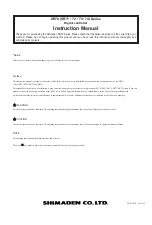
-
2 -
For matters regarding safety
SR70 series controller is designed for controlling temperature, humidity
and other physical subjects. It must not be used in any way that may
adversely affect the safety, health or working conditions of those who
come into contact with the effects of its usage. When used, adequate and
effective safety countermeasures must be provided at all times. No
warranty, express or implied, is valid in the case of using this product
without the use of proper safety countermeasures correspondingly.
WARNING
To avoid damage to the connected equipment, facilities or the product
itself due to a fault of the product, safety countermeasure must be taken
before usage, such as proper installation of the fuse and the overheating
protection device. No warranty, express or implied, is valid in the case of
usage without having implemented proper safety countermeasures.
CAUTION
•
The
mark on the plate affixed to the instrument:
On the terminal nameplate affixed to the case of your instrument, the
mark is printed. This is to warn you of the risk of electrical shock
which may result if the charger is touched while it is energized.
•
A means to allow the power to be turned off, such as a switch or a
breaker, should be installed in the external power circuit to be connected
to the power terminal of the instrument.
Fix the switch or the breaker adjacently to the instrument in a position
which allows it to be operated with ease, and with an indication that it is
a means of turning the power off. The switch or the breaker should meet
the requirements of IEC947.
•
Fuse:
Since the instrument does not have a built-in fuse, do not forget to install
a fuse in the power circuit to be connected to the power terminal.
The fuse should be positioned between the switch or the breaker and the
instrument and be attached to the L side of the power terminal.
Fuse Rating: 250V AC 0.5A/medium lagged or lagged type
Use a fuse which meets the requirements of IEC127.
•
Voltage/current of a load to be connected to the output
terminal and the alarm terminal should be within a rated range.
Otherwise, the temperature will rise and reduce the life of the product
and/or result in problems with the product.
For the rated voltage/current, see 7. Specifications on page 23.
The output terminal should be connected with a device which meets the
requirements of IEC1010.
•
A voltage/current different from that of the input specification should
not be added on the input terminal. It may reduce the life of the product
and/or result in problems with the product.
For the rated voltage/current, see 7. Specification on page 23.
For the rated voltage (mV or V) or current (4-20mA) input, the input
terminal should be connected with a device which meets the
requirements of IEC1010 as input terminals.
•
As the CT input terminal for the heater break alarm (optional), only the
attachment CT should be used. Using anything else may result in
problems with the product.
For the CT provided, refer to 1-1. Check before Use on page 11.
•
The SR70 series controller is provided with a draft hole for heat
discharge. Take care to prevent metal or other foreign matter from
obstructing it. Failure to do so may result in problems with the product
and may even result in fire.
•
Do not block the draft hole or allow dust or the like to adhere to it. Any
rise in temperature or insulation failure may result in a shortening of the
life of product and/or problems with the product. For spaces between
installed instruments, refer to 2-4. External Dimensions and Panel
Cutout on page 12.
•
It should be noted that repeated tolerance tests against voltage, noise,
surge, etc., may lead to deterioration of the instrument.
•
Remodeling the instrument or using it in an anomalous way is
prohibited.
CAUTION
Page
1. Introduction
...................................................................................3
1-1. Check before use.....................................................................3
1-2. Caution for use........................................................................3
2. Installation and wiring
.................................................................3
2-1. Installation site (environmental conditions) ...........................3
2-2. Mounting.................................................................................4
2-3. How to remove the instrument out of the case .......................4
2-4. External dimensions and panel cutout ....................................4
2-5. Wiring .....................................................................................5
2-6. Terminal arrangement.............................................................5
2-7. Terminal arrangement table ....................................................5
3. Instruction for front panel
...........................................................6
3-1. Drawing and the name of the parts .........................................6
3-2. Instruction for front panel .......................................................6
4. Screen instruction
........................................................................7
4-1. Power on and initial screen display ........................................7
4-2. Screen change .........................................................................7
4-3. Screen configuration ...............................................................8
4-4. Instruction for screen change and each screen........................9
4-5. Measuring range code table ..................................................10
4-6. Alarm type code table ...........................................................10
5. Operation
....................................................................................10
5-1. Setting of set value (SV) .......................................................10
5-2. AT (Auto tuning) ..................................................................11
5-3. Setting of alarm.....................................................................12
6. Supplement
................................................................................13
6-1. Auto return function..............................................................13
6-2. PID (Screen No.2,4 and 5 of mode 1 screen group) .............13
6-3. Control output characteristics ...............................................14
(
digit of mode 2 screen)
6-4. Error message .......................................................................14
7. Specifications
.............................................................................15
Contents
















